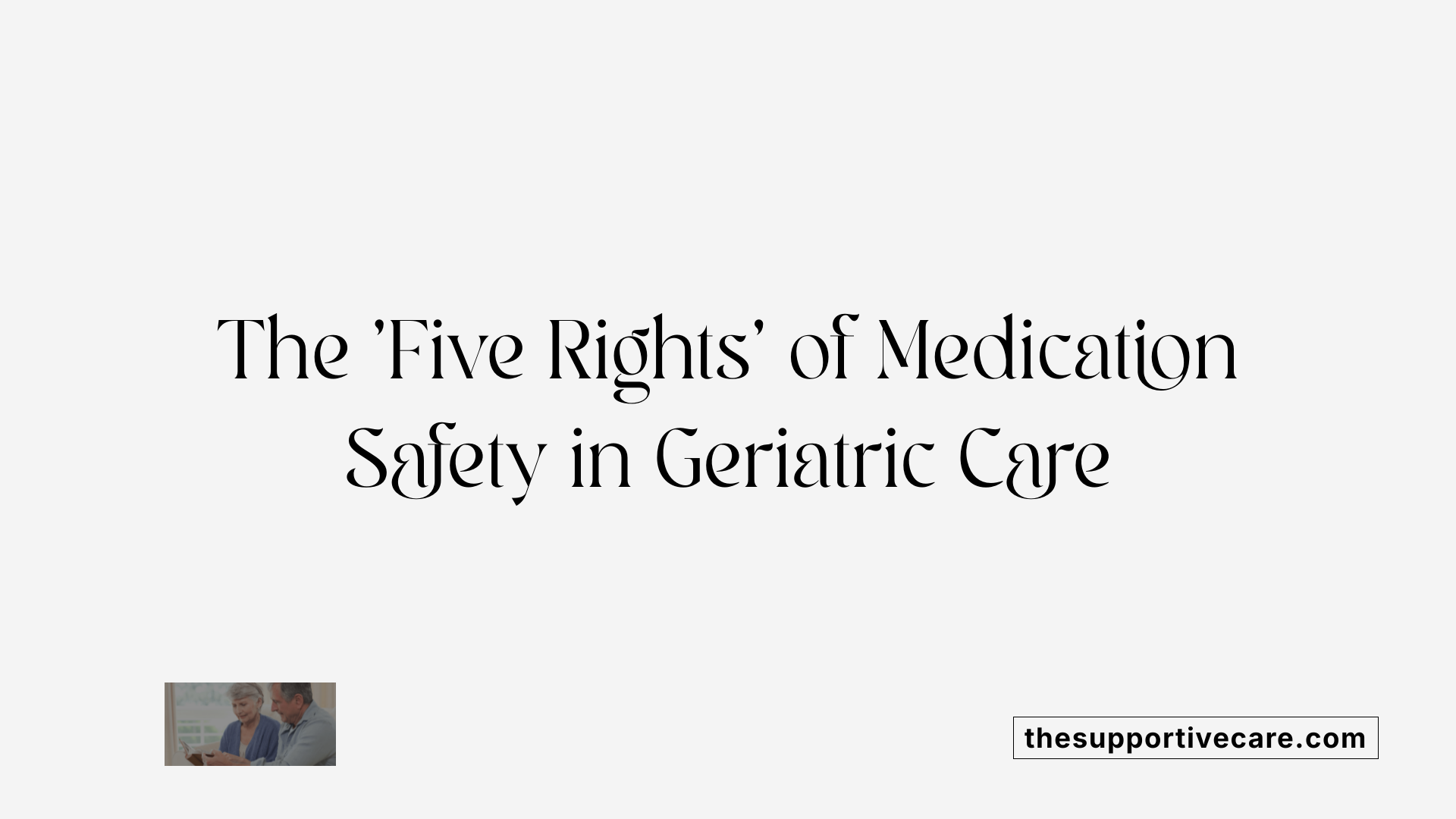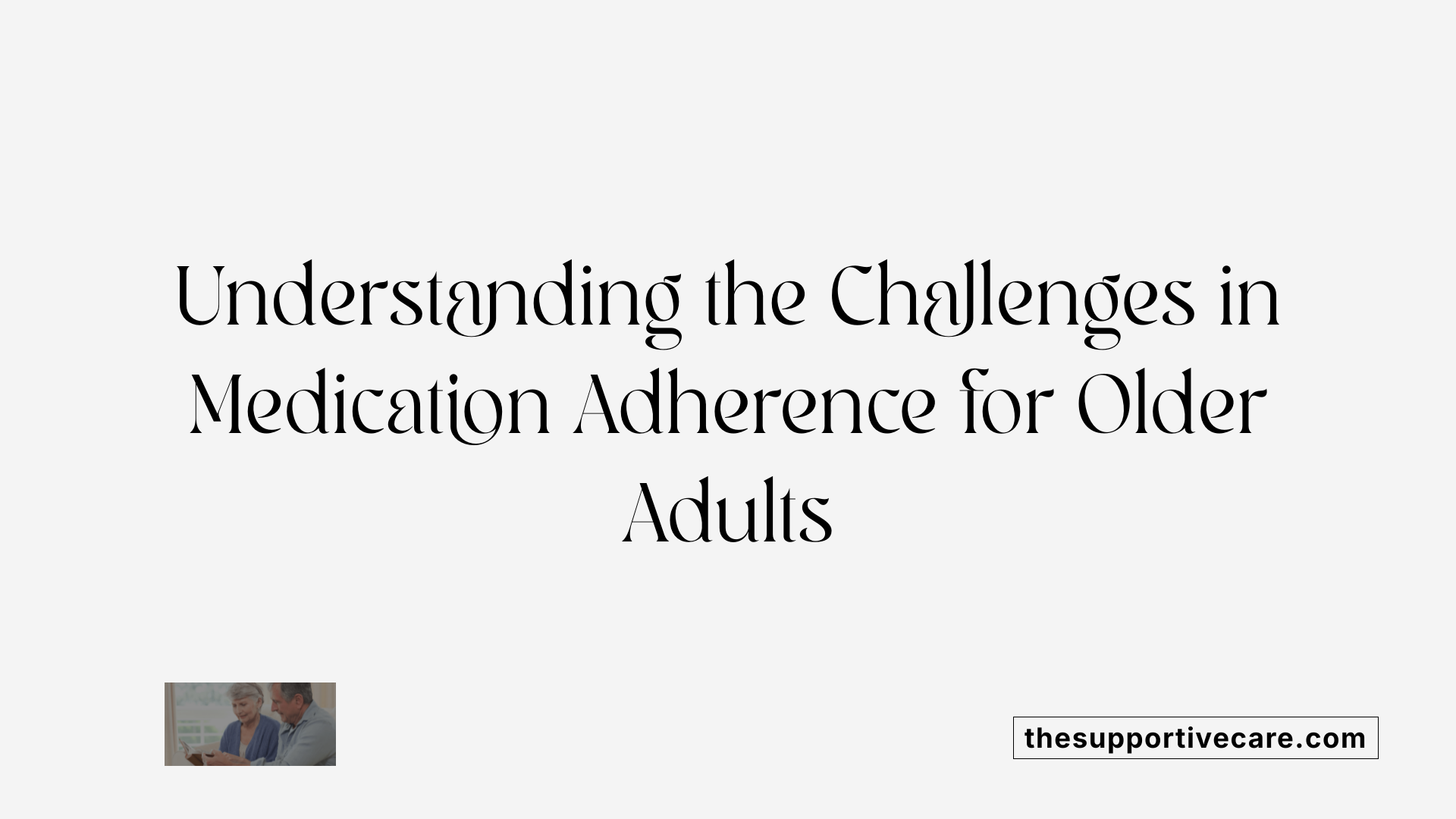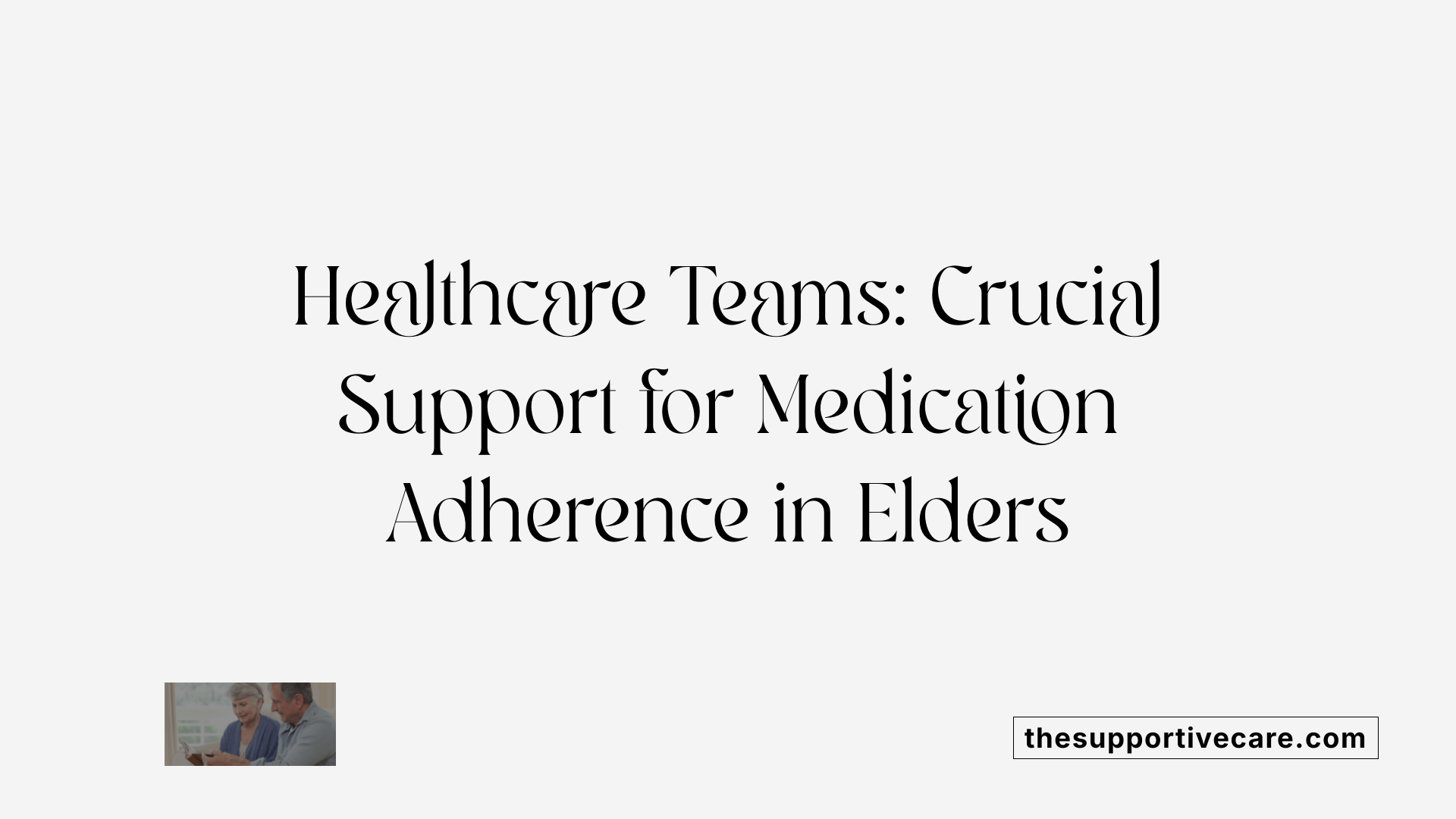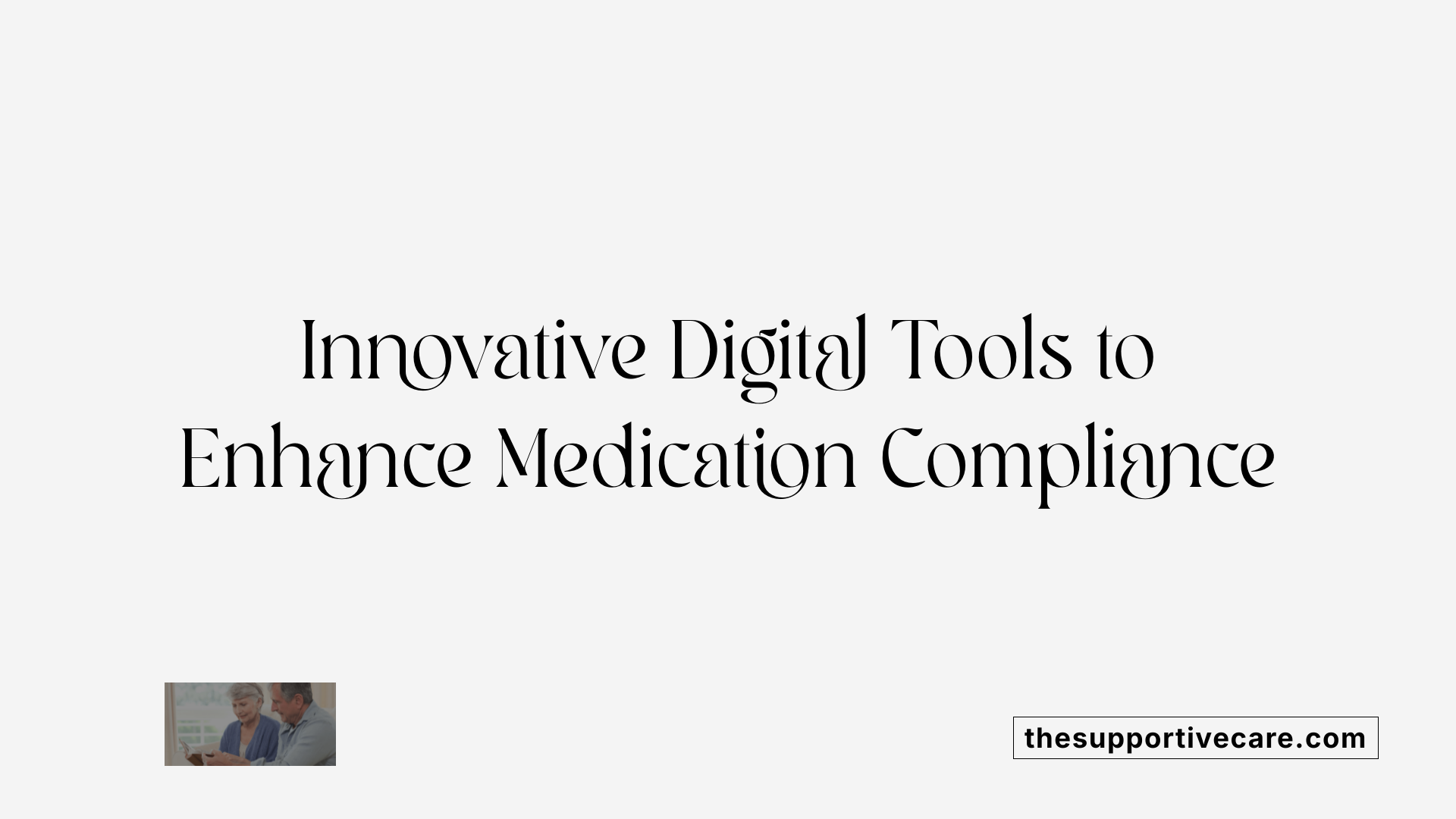Understanding the Importance of Medication Adherence in Older Adults
Medication adherence is vital for managing chronic diseases in the elderly, who often face unique barriers such as polypharmacy, cognitive decline, and socioeconomic challenges. Improving compliance not only enhances health outcomes but also reduces hospitalizations and healthcare costs. This article explores comprehensive strategies, including technological solutions and policy interventions, to optimize medication use among seniors.
Core Principles for Safe Medication Use in Elderly Patients

What are the 'five rights' of medication use?
The 'five rights' of medication use include the right patient, the right drug, the right dose, the right route, and the right time. These five principles form a basic framework that healthcare providers, especially nurses, follow to ensure medication safety. Before administering any medication, each of these aspects must be carefully verified.
For example, verifying the right patient involves checking patient identification tags and confirming their details. Ensuring the right drug means double-checking the medication label against the prescribed order. The right dose involves measuring the medication accurately, often with devices like syringes or pill counts. The right route refers to the correct method of administration, such as oral, injection, or topical. Finally, the right time involves giving the medication at the scheduled interval to maintain optimal therapeutic levels.
While following the 'five rights' significantly reduces medication errors, it should not be the sole safety measure. Healthcare providers must also exercise critical thinking, assess patient-specific factors, and utilize safety technologies like barcode scanning systems. This comprehensive approach helps safeguard elderly patients, who often have complex medication regimens, from adverse events and ineffective treatment.
How does barcode scanning contribute to medication safety?
Applying barcode scanning technology enhances medication safety in elderly care by providing an additional layer of verification during the medication administration process. Each medication container is labeled with a unique barcode, which can be scanned to confirm that the correct medication is being given to the right patient.
When integrated with electronic health records, barcode scanning ensures real-time validation of the medication against the patient's prescribed regimen. This minimizes human errors like wrong medication selection, dosing mistakes, or administering medication to the wrong patient.
Furthermore, barcode systems can alert healthcare providers if discrepancies are detected, such as allergies or drug interactions, before administration occurs. This technology complements the traditional 'five rights' and promotes a culture of safety.
In elderly patients, who often have multiple medications and complex health conditions, barcode scanning reduces the risk of adverse drug events. It streamlines medication management, supports accurate documentation, and enhances overall patient safety.
The importance of critical thinking in medication administration
While technology and protocols like the 'five rights' are vital, critical thinking remains essential in medication management, especially for older adults. Healthcare providers must evaluate contextual factors, such as patient-specific health conditions, potential drug interactions, and individual preferences.
For instance, even if a barcode scan confirms correct medication and dose, clinicians should assess whether the timing aligns with the patient's unique lifestyle or medical needs. They should also consider if the medication regimen can be simplified to improve adherence, particularly in elderly patients with cognitive or physical limitations.
Critical thinking also involves vigilant assessment for side effects, signs of adverse reactions, and understanding the implications of polypharmacy common in older adults. By integrating clinical judgment with technological tools, healthcare providers can optimize medication safety and effectiveness.
Summarized overview of medication safety in elderly care
| Aspect | Description | Additional Notes |
|---|---|---|
| The 'five rights' | Verifying patient, drug, dose, route, and time | Fundamental guideline for safe administration |
| Barcode scanning | Technology-assisted verification | Reduces errors and prevents adverse events |
| Critical thinking | Clinical judgment and contextual assessment | Essential for nuanced decision-making |
| Patient involvement | Education and participation | Improves adherence and safety |
| Simplification | Regimen optimization | Promotes better compliance in elderly |
In conclusion, ensuring medication safety in elderly patients requires a combination of fundamental principles like the 'five rights,' the strategic use of advanced technologies such as barcode scanning, and a thoughtful, patient-centered approach facilitated by critical thinking. Together, these strategies help mitigate risks associated with polypharmacy and complex medication regimens, ultimately improving health outcomes in this vulnerable population.
Recognizing and Overcoming Barriers to Adherence

What are the main challenges and barriers to medication compliance among older adults?
Older adults face multiple obstacles that can significantly impede their ability to adhere to prescribed medication regimens. One of the main issues is cognitive decline, which often results in forgetfulness, confusion, and difficulty understanding instructions on medication use. This can lead to missed doses or incorrect medication intake. Physical limitations, such as arthritis, visual impairment, or difficulty swallowing, further complicate the process of medication management.
Polypharmacy, the use of five or more medications concurrently, is common in this age group and increases the complexity of adherence. Managing multiple drugs with different dosing schedules can cause confusion, errors, and unintended noncompliance. Additionally, adverse side effects from medications can lead patients to intentionally skip doses or stop treatment altogether.
Financial constraints are another significant barrier. Many older adults live on fixed incomes, making it difficult to afford their medications. The high cost can result in skipped doses, delayed refills, or not filling prescriptions at all. Furthermore, low health literacy hampers patients' understanding of their health conditions and the importance of their medications. Poor communication between healthcare providers and patients often exacerbates these issues, as patients may not fully grasp the purpose of their treatments or how to manage side effects.
The absence of social support or caregiver assistance also affects adherence. Caregivers and family members play a vital role in helping organize medications, providing reminders, and communicating with healthcare professionals. Without this support, elderly patients are more vulnerable to unintentional nonadherence.
Logistic challenges such as transportation issues prevent timely visits to pharmacies or healthcare providers, further interfering with proper medication management. Lastly, limited awareness of medication-related risks or potential interactions can result in unsafe medication practices, increasing the likelihood of hospitalizations or adverse health outcomes.
Main barriers to medication adherence include:
- Cognitive decline affecting memory and understanding
- Physical limitations hindering medication administration
- Complex, multi-drug regimens (polypharmacy)
- Side effects leading to intentional nonadherence
- Financial hardship reducing medication access
- Low health literacy and poor provider communication
- Lack of social and caregiver support
- Transportation and accessibility issues
- Limited awareness of medication risks and interactions
Addressing these multifaceted challenges requires a comprehensive, patient-centered approach that considers the individual needs, circumstances, and barriers faced by older adults.
Determinants of Adherence: Influencing Factors
What factors influence medication adherence in the elderly?
Medication adherence among older adults is influenced by a confluence of factors related to the individual, the medication itself, the healthcare system, and social support networks.
Patient-related factors are significant. Cognitive impairments, such as memory problems or dementia, often lead to missed doses or incorrect medication use. Mental health issues like depression can diminish motivation to adhere to prescribed regimens. Physical limitations, such as difficulty swallowing pills or impaired dexterity, further complicate medication management. Additionally, health literacy—the ability to understand health-related information—plays a critical role. Patients with limited understanding about their conditions or medications are less likely to follow treatment plans properly.
Medication-related issues are also influential. The complexity of regimens, especially those requiring multiple doses or different medications at various times, can be overwhelming. Side effects and adverse reactions discourage continued use. Formulation problems, difficulties in swallowing pills or using inhalers, and the high cost of certain drugs can serve as barriers.
Healthcare provider communication and follow-up are crucial. Patients who trust their providers and receive clear, understandable information are more likely to adhere. Regular follow-up helps identify barriers early and allows adjustments to regimens. System-level supports such as patient education programs, medication reconciliation, and accessible healthcare services further reinforce adherence.
Social determinants, including socioeconomic status, have a profound impact. Financial constraints often lead to skipped doses or non-filling of prescriptions. The involvement of family members or caregivers enhances adherence by assisting with medication management, providing reminders, and supporting emotional well-being.
In conclusion, these multifaceted factors highlight the importance of tailored interventions. Strategies such as simplifying medication regimens, providing comprehensive education, utilizing technological aids, and strengthening social supports are vital in promoting better medication adherence among the elderly.
Identifying and Managing Risk Factors for Nonadherence
What are common risk factors and causes of medication nonadherence in seniors?
Older adults often face multiple barriers that impact their ability to adhere to prescribed medication regimens. Cognitive impairment, which can include memory problems or conditions like dementia, significantly increases the risk of forgetting doses or taking medications incorrectly. Complex medication schedules, often seen with polypharmacy—using five or more medications—pose challenges in managing timing and dosages.
Financial constraints are also a major contributor. When medication costs surpass 10% of a person's medical expenses, seniors are more likely to skip doses or avoid filling prescriptions altogether. Limited health literacy further compounds these issues, as understanding medication instructions, recognizing side effects, or knowing the importance of adherence can be difficult.
Poor communication with healthcare providers and insufficient patient education may lead to misconceptions about the treatment, resulting in accidental nonadherence. Physical impairments, such as poor eyesight or motor difficulties, can interfere with medication administration, especially if packaging is complicated or pills are difficult to handle.
Environmental challenges, like difficulties in storing medications safely or retrieving them, add to the problem. Social factors, including lack of caregiver support or social isolation, also hinder consistent medication use.
How can targeted interventions reduce these risks?
Addressing these multifaceted barriers requires a combination of strategies. Regular medication reviews by healthcare professionals can identify unnecessary drugs and simplify complex regimens, especially by reducing dose frequency or using combination pills.
Improving patient education through personalized counseling and written materials helps reinforce understanding of medication benefits, proper use, and potential side effects. Use of visual aids, teach-back methods, and culturally sensitive communication are effective tools.
Caregivers play a vital role by helping organize medications, providing reminders, and supporting transportation to appointments. Ensuring easy access to medications—such as coordinated home delivery or simplified storage solutions—further enhances adherence.
Technological tools like electronic reminders, medication apps, or barcode scanning can serve as prompts for patients. Pharmacist-led interventions, including medication reconciliation and adherence counseling, have demonstrated positive outcomes, especially when tailored to individuals' specific needs.
In addition, addressing financial barriers by guiding patients toward assistance programs or generic medication options can significantly improve adherence.
In summary, recognizing the diverse risk factors that affect medication adherence in seniors enables healthcare providers to implement comprehensive, patient-centered solutions that improve health outcomes and quality of life.
| Risk Factors | Contributing Factors | Strategies for Management |
|---|---|---|
| Cognitive impairment | Memory loss, dementia | Cognitive behavioral therapy, reminders, caregiver involvement |
| Complex regimens | Multiple medications, dosing frequency | Simplification, combination pills, medication reconciliation |
| Polypharmacy | Use of 5+ drugs, drug interactions | Regular review, deprescribing where appropriate |
| Financial barriers | High cost, limited income | Assistance programs, generic options, insurance navigation |
| Low health literacy | Poor understanding of instructions | Personalized education, teach-back method |
| Physical impairments | Visual, motor difficulties | Adaptive packaging, dosing aids |
| Poor provider communication | Limited time, incomplete info | Better dialogue, shared decision-making |
| Environmental issues | Storage, access | Easy-to-store medication systems, home delivery |
| Social support deficits | Caregiver absence, social isolation | Caregiver education, support groups |
Understanding these factors assists healthcare professionals in designing effective interventions, ultimately enhancing medication adherence among the elderly.
The Critical Role of Healthcare Professionals and Pharmacists

What role do healthcare providers and pharmacists play in promoting medication adherence?
Healthcare providers, including doctors, nurses, and pharmacists, are at the forefront of encouraging patients to follow their medication regimens effectively. They do this by providing education about the importance of adherence, explaining how medications work, and discussing potential side effects and benefits. Building trusting relationships is crucial; when patients trust their providers, they are more likely to follow medical advice.
Pharmacists, in particular, have a vital role in supporting adherence through personalized counseling. They assess barriers patients may face, such as difficulty understanding instructions, forgetfulness, or financial constraints. Pharmacists also offer tailored interventions, like organizing medications with pillboxes, using reminder systems, and suggesting simpler dosing schedules, such as once-daily pills, to improve compliance.
Evidence-based communication strategies, including motivational interviewing, are employed by pharmacists to reinforce positive behaviors and address patient concerns. Collaborative care models encourage regular information sharing between pharmacists and other healthcare providers, which helps coordinate treatment plans and reinforces adherence efforts.
Community pharmacists are especially well-positioned to provide ongoing support. They can organize pharmacy-based programs, monitor medication use, and offer continuous advice to ensure patients stay on track. This team-based, patient-centered approach emphasizes effective communication, individualized interventions, and routine follow-ups.
In summary, both healthcare providers and pharmacists are essential in promoting medication adherence by educating patients, addressing individual barriers, fostering trust, and maintaining coordinated care. Their combined efforts are crucial for improving health outcomes and ensuring safe, effective medication use.
How do interventions by healthcare professionals influence medication adherence?
Interventions by healthcare professionals—including medication reviews, counseling, and follow-up—have been shown to significantly boost adherence rates among older adults. For example, pharmacist-led medication management programs that include counseling on proper use, monitoring for side effects, and simplifying regimens can lead to better adherence.
Behavioral strategies such as motivational interviewing, personalized education, and treatment planning that involves the patient’s preferences and concerns have demonstrated positive effects in various populations. Face-to-face counseling and telehealth approaches tailored to patient needs show promising results, especially when combined with reminder tools and adherence aids.
Overall, active engagement and personalized interventions by healthcare providers directly impact patients' willingness and ability to follow prescribed treatment, thereby improving health outcomes.
Harnessing Digital Technology for Better Adherence

How can digital health solutions and technological aids assist with medication management?
Digital health solutions and technological aids have emerged as powerful tools to improve medication adherence among older adults. These innovations include electronic pill bottles that track and remind users to take their medication, ingestible sensors that confirm pill ingestion, and mobile applications (apps) designed to send alerts and gather adherence data.
Real-time monitoring features allow healthcare providers to observe medication-taking behaviors remotely, enabling early intervention if doses are missed. Automated refill services through apps reduce the chances of running out of medication, while communication platforms facilitate direct interaction between patients and providers, supporting clarifications about side effects or dosing.
Integration with electronic health records (EHRs) and clinical systems enhances the continuity of care by linking adherence data with other health information. This comprehensive approach helps clinicians tailor treatments, identify barriers, and implement personalized strategies.
Additional digital tools like telehealth consultations, wearable sensors, and artificial intelligence (AI) analytics contribute further to personalized and proactive care. These technologies support behavioral modification and provide customized reminders suited to individual routines.
Despite the promising benefits, challenges such as ensuring data accuracy, maintaining user acceptability among older adults, addressing security concerns, and validating regulatory standards must be overcome. Optimizing these digital aids requires thoughtful design, user training, and robust system integration to truly transform medication management and improve health outcomes.
What are some specific digital health aids for elderly medication compliance?
| Tool Type | Function | Advantage |
|---|---|---|
| Electronic pill bottles | Tracks medication usage, sends reminders | Reduces missed doses, improves adherence |
| Ingestible sensors | Confirm medication ingestion digitally | Accurate tracking, real-time data |
| Mobile apps | Provide alerts, educational materials, and refill alerts | User-friendly, customizable, enhances engagement |
| Telehealth platforms | Enable remote consultations and follow-ups | Improves access, timely management |
| Wearable sensors | Monitor physiological responses related to medication intake | Detects adverse reactions early |
| AI-based analytics | Analyze adherence patterns and suggest interventions | Personalized support, data-driven strategies |
Future Perspectives and Considerations
The ongoing development of digital health tools offers immense potential to support elderly patients with medication adherence. These solutions can be customized based on individual health status, lifestyle, and technological comfort levels.
However, extensive research is necessary to validate their effectiveness, address privacy and security issues, and ensure ease of use for older users. Successful implementation depends on collaboration among tech developers, healthcare providers, and patients.
In conclusion, digital health aids are revolutionizing medication management by offering innovative, efficient, and personalized adherence support. As these technologies mature, they hold promise for significantly reducing nonadherence rates and improving overall health outcomes for the aging population.
Innovative Approaches and Future Directions
What techniques can improve patient engagement and education to enhance medication compliance?
Enhancing medication adherence among older adults requires a tailored, patient-centered approach. Healthcare providers should prioritize personalized counseling that addresses individual patient needs, beliefs, and cultural backgrounds. Using clear, simple educational materials and visual aids helps overcome health literacy barriers, making complex information more accessible.
Digital tools such as mobile apps, patient portals, and automated reminders can reinforce adherence habits. These technologies serve as continuous prompts and educational resources, especially when designed with user-friendly interfaces suited for older adults.
Building trust through shared decision-making encourages patients to actively participate in their treatment plans. Proactively discussing concerns, preferences, and potential barriers fosters motivation and a sense of ownership.
Addressing practical barriers—like complicated dosing schedules or high medication costs—by simplifying regimens, offering medication synchronization, and providing affordable drug options improves compliance.
Additionally, involving family members, caregivers, and community support systems ensures a comprehensive network supporting adherence. Regular follow-ups using telehealth or home visits can evaluate progress and reinforce education.
All these strategies aim to empower patients, promote sustained engagement in their health management, and ultimately improve medication adherence.
What techniques can improve patient engagement and education to enhance medication compliance?
Improving medication adherence involves effective communication, tailored education, and support systems. Healthcare providers should employ personalized counseling, ensuring that information is relevant and understandable. Visual aids, language simplification, and culturally appropriate materials help bridge understanding gaps.
Digital health solutions such as mobile apps, electronic pill reminders, and online patient portals offer additional reinforcement tools. These technologies provide timely prompts and allow patients to track their medication schedules easily.
Fostering a trusting, collaborative relationship between providers and patients motivates adherence. Engaging patients in shared decision-making and openly discussing their concerns builds confidence and commitment.
Removing barriers like complex regimens, financial constraints, and poor health literacy contributes significantly to compliance. Simplifying medication routines—such as using combination pills or once-daily dosing—and providing clear, simple instructions support better adherence.
Family involvement and community resources further strengthen support networks. Routine follow-ups, whether via telehealth or in-person, reinforce educational efforts and help address ongoing challenges.
By integrating these strategies, healthcare systems can create a supportive environment that encourages consistent medication use.
What are systematic review findings regarding effective medication adherence strategies?
Systematic reviews highlight that multifaceted interventions are most effective in improving medication adherence. Principal among these are dose simplification, patient education based on behavioral theories, and technological aids.
Reducing dosing frequency—e.g., shifting to once-daily pills—consistently shows adherence improvements across various studies. Educational interventions grounded in models like the health belief or cognitive-behavioral frameworks enhance patients' understanding of their medication's importance and address misconceptions.
Electronic reminders, such as SMS alerts, digital pillboxes, and telehealth monitoring, demonstrate positive, though variably robust, effects on adherence. These tools help mitigate forgetfulness, a common barrier among older adults.
Financial incentives, subsidies, and reduced copayment schemes can also influence adherence, especially when combined with other approaches.
Despite promising results, the overall quality of evidence varies. Combining strategies—tailored to individual needs and circumstances—is generally more effective than singular approaches. Future research must continue to refine these interventions, emphasizing high-quality, large-scale studies to establish best practices for elderly populations.
Summing Up: Strategies for Lasting Compliance
Improving medication adherence in elderly patients demands a multifaceted, patient-centered approach integrating education, regimen simplification, technology, and systemic support. Digital health tools, personalized counseling, caregiver involvement, and policy interventions like affordability measures are vital to overcoming barriers. Regular medication reviews and deprescribing processes reduce polypharmacy risks and streamline regimens. Collaborative care models emphasizing trust, communication, and tailored interventions foster better understanding and motivation among seniors. As research advances and innovative solutions emerge, continual adaptation of strategies to individual needs ensures sustained compliance, ultimately enhancing health outcomes, safety, and quality of life for older adults.
References
- Improving Medication Adherence in Older Adults
- Improving Medication Adherence and Health Outcomes in Older ...
- A study of medication compliance in geriatric patients with chronic ...
- MedHerent: Improving Medication Adherence in Older Adults With ...
- Polypharmacy and Drug Adherence in Elderly Patients
- Effects of medication adherence interventions for older adults with ...
- Promoting Medication Adherence in Older Adults … and the Rest of Us
- Improving Medication Compliance in the Elderly Strategies For the ...
- Optimizing Medication Adherence: Strategies for Physicians in ...



































































































